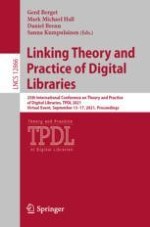This book constitutes the proceedings of the 25th International Conference on Theory and Practice of Digital Libraries, TPDL 2021, held in September 2021. Due to COVID-10 pandemic the conference was held virtually.
The 10 full papers, 3 short papers and 13 other papers presented were carefully reviewed and selected from 53 submissions. TPDL 2021 attempts to facilitate establishing connections and convergences between diverse research communities such as Digital Humanities, Information Sciences and others that could benefit from ecosystems offered by digital libraries and repositories. This edition of TPDL was held under the general theme of “Linking Theory and Practice”. The papers are organized in topical sections as follows: Document and Text Analysis; Data Repositories and Archives; Linked Data and Open Data; User Interfaces and Experience.
